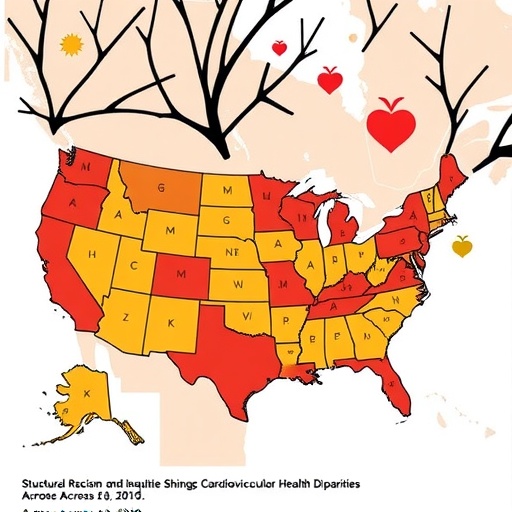Emerging research in the realm of public health increasingly point to the intricate ways structural racism imprints itself upon the cardiovascular health of communities. A groundbreaking cross-sectional study, recently published in the prestigious JAMA Health Forum, underscores the significant association between systemic racial inequalities and disparities in neighborhood-level cardiovascular health outcomes. This study not only deepens our understanding of how social determinants can translate into tangible health inequities but also spotlights the potential for targeted, place-based interventions to mitigate these disparities.
At the core of this study lies a sophisticated analysis of the multifaceted nature of structural racism — a complex framework comprising policies, institutional practices, cultural representations, and other norms that perpetuate racial group inequity. Unlike individual-level racism, structural racism is embedded within societal systems and manifests in limited access to resources, including quality healthcare, nutritious foods, safe housing, and education, all crucial factors that influence cardiovascular health.
The authors of the study meticulously correlated measures of structural racism with cardiovascular health metrics aggregated at the neighborhood level. This approach allowed an unprecedented examination of how entrenched social structures impact health beyond individual risk behaviors or genetic predispositions. By employing an array of quantitative tools, including geospatial mapping and advanced statistical models, the researchers charted a robust link between higher indices of structural racism and poorer cardiovascular outcomes within marginalized neighborhoods.
One striking component of the findings is the elucidation of how neighborhood environments shape cardiovascular risk factors such as hypertension, obesity, diabetes, and stroke. Neighborhoods characterized by concentrated poverty, residential segregation, and limited healthcare infrastructure were found to have disproportionately high rates of these conditions. These clusters not only reflect historic and ongoing structural exclusion but also create cycles of health disadvantage that are difficult to break without systemic change.
From a pathophysiological perspective, chronic exposure to structural racism-related stressors likely exacerbates cardiovascular disease through multiple mechanisms. These include activation of the hypothalamic-pituitary-adrenal axis leading to elevated cortisol levels, increased systemic inflammation, endothelial dysfunction, and autonomic imbalance. The tangible physiological burden imposed by persistent social stress underscores the urgent need to understand cardiovascular health through a socio-environmental lens.
Importantly, the study highlights the indispensable value of place-based prevention strategies. Instead of solely focusing on individual behavior modification, the research advocates for systemic interventions that transform neighborhood environments. Strategies such as improving access to primary care, enhancing public spaces to encourage physical activity, addressing food deserts, and reforming housing policies have the potential to alter the cardiovascular health landscape dramatically in structurally marginalized communities.
The implications of these findings extend beyond public health research into policy realms. Researchers and policymakers alike must recognize that tackling cardiovascular disparities necessitates dismantling structural racism itself. This involves reimagining urban planning, economic investment, education equity, and legal frameworks to foster environments conducive to health equity across racial groups.
Methodologically, this study exemplifies the power of interdisciplinary collaboration. Epidemiologists, sociologists, public health experts, and biostatisticians converged to dissect the multidimensional construct of structural racism and its health sequelae. Such integrative approaches enrich the scientific narrative, enabling more comprehensive and actionable insights into complex societal challenges.
Future directions stemming from this study call for longitudinal investigations that track how changes in structural determinants impact cardiovascular health trajectories over time. Integrating biomarker analysis and community-based participatory research could deepen mechanistic understanding and ensure that interventions are culturally sensitive and community-informed.
While the current study stops short of testing specific interventions, its robust evidence base lays the groundwork for designing targeted programs that address root causes. This pivot toward systems-level solutions signals a paradigm shift in cardiovascular disease prevention — one that places equity at the heart of scientific inquiry and health practice.
In sum, this pivotal research elucidates the profound interplay between structural racism and cardiovascular health disparities at the neighborhood level. It challenges clinicians, researchers, and policymakers to confront social determinants as indispensable targets for cardiovascular disease prevention. By doing so, the path opens toward a more equitable and healthier future for all communities.
As cardiovascular disease remains the leading cause of death globally, unveiling the hidden social drivers such as structural racism is essential. This study, through its rigorous and innovative analysis, offers a clarion call to integrate social justice with cardiovascular medicine, ultimately fostering a holistic approach to public health.
For those eager to delve deeper into the technical specifics and data sets behind these conclusions, the full study is accessible through the JAMA Health Forum.
Subject of Research: Association of structural racism with neighborhood-level cardiovascular health disparities
Article Title: [Not provided in the original content]
News Publication Date: [Not provided in the original content]
Web References: [DOI: 10.1001/jamahealthforum.2025.3864]
References: [Not provided in the original content]
Image Credits: [Not provided in the original content]
Keywords: Cardiovascular disease
Tags: access to healthcare and nutritioncultural representations and health outcomesgeospatial mapping in health studiesimpact of housing on cardiovascular healthinstitutional practices and health inequitiesneighborhood-level health disparitiesplace-based interventions for healthpublic health research on racismsocial determinants of health inequitiesstructural racism and cardiovascular healthsystemic racial inequalities in healthunderstanding health disparities in communities





